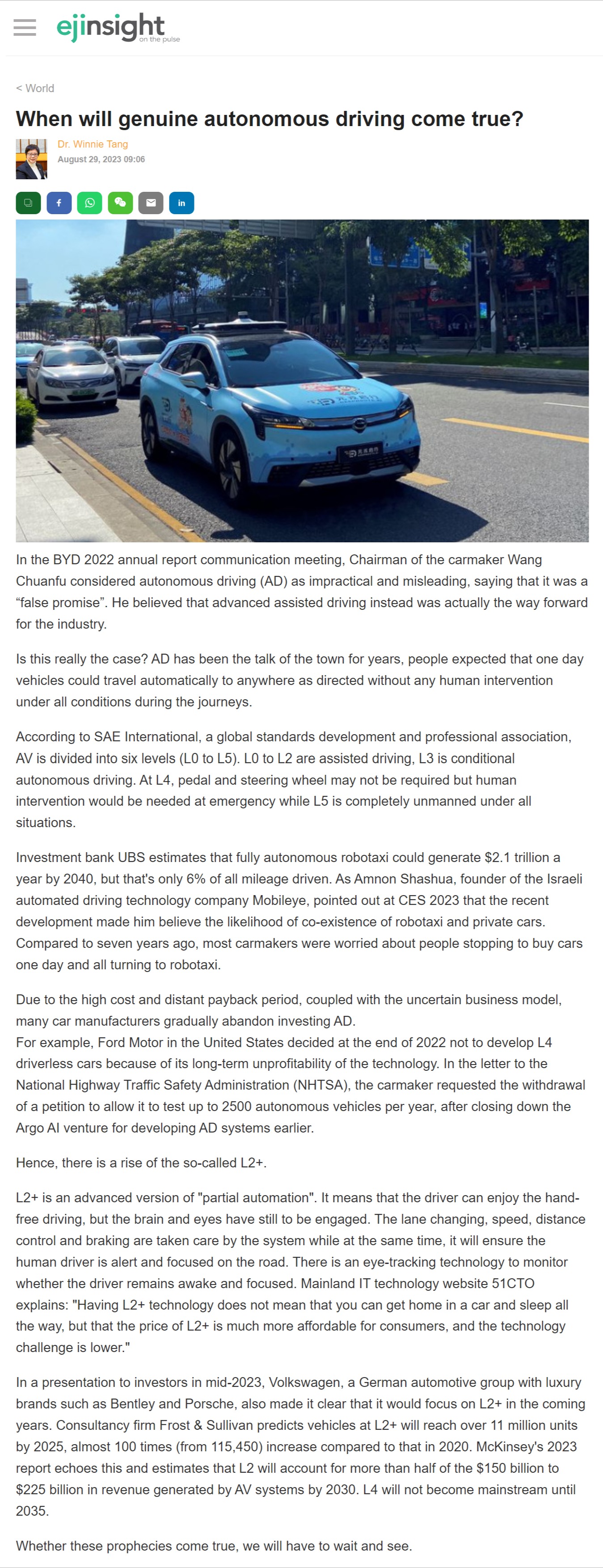網上版請按此

When will genuine autonomous driving come true?
In the BYD 2022 annual report communication meeting, Chairman of the carmaker Wang Chuanfu considered autonomous driving (AD) as impractical and misleading, saying that it was a "false promise". He believed that advanced assisted driving instead was actually the way forward for the industry.
Is this really the case? AD has been the talk of the town for years, people expected that one day vehicles could travel automatically to anywhere as directed without any human intervention under all conditions during the journeys.
According to SAE International, a global standards development and professional association, AV is divided into six levels (L0 to L5). L0 to L2 are assisted driving, L3 is conditional autonomous driving. At L4, pedal and steering wheel may not be required but human intervention would be needed at emergency while L5 is completely unmanned under all situations.
Investment bank UBS estimates that fully autonomous robotaxi could generate $2.1 trillion a year by 2040, but that's only 6% of all mileage driven. As Amnon Shashua, founder of the Israeli automated driving technology company Mobileye, pointed out at CES 2023 that the recent development made him believe the likelihood of co-existence of robotaxi and private cars. Compared to seven years ago, most carmakers were worried about people stopping to buy cars one day and all turning to robotaxi.
Due to the high cost and distant payback period, coupled with the uncertain business model, many car manufacturers gradually abandon investing AD.
For example, Ford Motor in the United States decided at the end of 2022 not to develop L4 driverless cars because of its long-term unprofitability of the technology. In the letter to the National Highway Traffic Safety Administration (NHTSA), the carmaker requested the withdrawal of a petition to allow it to test up to 2500 autonomous vehicles per year, after closing down the Argo AI venture for developing AD systems earlier.
Hence, there is a rise of the so-called L2+.
L2+ is an advanced version of "partial automation". It means that the driver can enjoy the hand-free driving, but the brain and eyes have still to be engaged. The lane changing, speed, distance control and braking are taken care by the system while at the same time, it will ensure the human driver is alert and focused on the road. There is an eye-tracking technology to monitor whether the driver remains awake and focused. Mainland IT technology website 51CTO explains: "Having L2+ technology does not mean that you can get home in a car and sleep all the way, but that the price of L2+ is much more affordable for consumers, and the technology challenge is lower."
In a presentation to investors in mid-2023, Volkswagen, a German automotive group with luxury brands such as Bentley and Porsche, also made it clear that it would focus on L2+ in the coming years. Consultancy firm Frost & Sullivan predicts vehicles at L2+ will reach over 11 million units by 2025, almost 100 times (from 115,450) increase compared to that in 2020. McKinsey's 2023 report echoes this and estimates that L2 will account for more than half of the $150 billion to $225 billion in revenue generated by AV systems by 2030. L4 will not become mainstream until 2035.
Dr. Winnie Tang
Adjunct Professor, Department of Computer Science, Faculty of Engineering; Department of Geography, Faculty of Social Sciences; and Faculty of Architecture, The University of Hong Kong